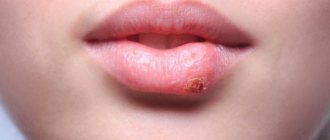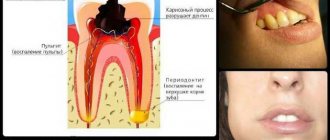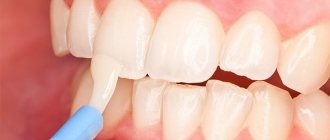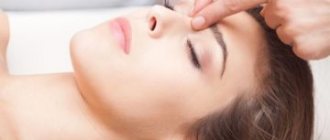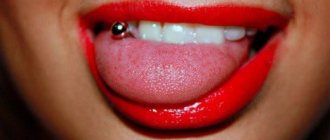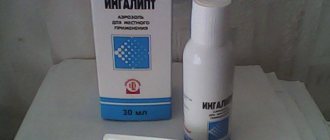First aid measures
Probably everyone knows that pain cannot be tolerated. This can cause a weakened immune system due to constant pain. To alleviate the general condition until it is possible to contact a specialist, it is necessary to take urgent measures using traditional methods.
We must not forget that if at home it was possible to alleviate the pain syndrome, it does not occur over the next 24 hours. There is still no need to cancel your visit to the doctor. The inflammatory process of a nerve that has been suppressed can continue to develop without obvious symptoms, and this is fraught with its transition to a severe stage and the occurrence of dangerous consequences.
If you cannot bear the pain, you can take any painkiller, for example, Sedalgin. The symptom will begin to decrease in intensity within 15–20 minutes. Drugs such as Nurofen and Ketanov cope well not only with pain, but also with the inflammatory process in general.
As a first aid measure for toothache, use propolis. It is used as a compress, or rather, an infusion: a few drops should be placed on cotton wool and applied to the sore area. The indicated dosage is the maximum; it is not recommended to exceed it. Otherwise, you can cause a burn to the mucous membrane. Leave the compress on for no more than 30 minutes.
Reference. You can relieve sudden pain with an ice compress. Apply a piece of ice to the cheek on the side of the painful tooth. The compress is kept for 7-10 minutes, no longer, this helps remove the gumboil.
It is prohibited to apply dry heat, since increased blood circulation in the area of the inflamed wisdom tooth increases the intensity of pain. You should not lie down during a toothache. This position also ensures increased blood flow to the jaw, and this causes increased pressure on the tooth tissue and an increase in the syndrome.
After suppressing the discomfort, it is recommended to brush your teeth and rinse your mouth with a soda solution. For several hours, you need to limit your food intake if there is a hole in the tooth. Getting food into it can cause pain.
How to cure pulpitis at home
photo from the site: dentalgu.ru
Pulpitis is an inflammation of the pulp of the tooth , which is preceded by an advanced stage of caries. It is not recommended to treat this disease at home due to possible complications. In this case, home remedies will be auxiliary for pain relief, but within no more than three days you need to seek help from a dental specialist. Failure to see a doctor within three days may result in the risk of periostitis, phlegmon, or blood poisoning.
When treating this dental disease the following is used:
- Rinsing. This procedure is good for relieving pain and inflammation. For rinsing the mouth, decoctions of herbs are used - sage, chamomile, calendula, willow bark, basil, calamus. Hydrogen peroxide, soda, propolis are also suitable; they are diluted in warm water.
- Mouth baths. Almost all infusions and decoctions of medicinal natural herbs are used for this procedure. You need to take the warm broth into your mouth, hold it for a while and spit it out. Apply the procedure daily, every 1.5 - 2 hours.
- Lotions and compresses. It is necessary to soak a cotton swab with infusion or decoction. Apply to the inflamed area and hold for some time. The procedure is repeated three to five times a day.
- Rubbing. A paste-like product made from natural ingredients is applied to the gums and slowly rubbed in until everything is absorbed.
Sage infusion has antibacterial and analgesic properties. You need to rinse your mouth with this decoction every two or three hours every day.
A decoction based on calamus and propolis has an analgesic effect and at the same time disinfects the oral cavity. To do this, you need to mix one tablespoon of calamus with one teaspoon of propolis tincture in alcohol and dilute with warm water. Regular mouth rinsing is necessary for a month. Also, propolis itself, or more precisely a piece cut from it, is applied to the diseased tooth. As a rule, the pain calms down within a short time.
Willow bark also has an anti-inflammatory and analgesic effect. To use it, you need to brew two teaspoons of bark and let it sit. Then get rid of the brewed bark and use the infusion for rinsing and bathing the mouth.
Acupressure
To get rid of pain, you need to press on certain points located in different areas of the body. Such an effect will help to quickly reduce the intensity of the syndrome, and after some time, completely suppress it. Areas where the points are located:
- Palm - the back side, between the index finger and thumb (the point is pressed with the thumb for several minutes).
- Palm - 2 cm below the middle of the ring and middle fingers (press with a nail until discomfort appears in this area).
- Index finger – left corner of the nail (apply light pressure with the finger until pain appears in this area).
- Left cheek - the depression between the jaws (press lightly with the index finger 5 times, and then massage in a circular motion 25-30 times).
- Wrist – in the area where you can feel the pulse (you can massage it with your finger or rub it with garlic).
You can treat your teeth at home using acupressure.
Controversial methods of traditional medicine
The most famous folk remedies that relieve toothache at home are all kinds of lotions and applications. This includes lard, beets, propolis, vodka, and even pieces of ice. As reflexology, it is suggested to apply a magnet to the cheek, a heating pad to the back of the head, and garlic to the hand opposite the painful tooth. There is even advice that pressing a certain point on the carotid artery will help get rid of toothache.
The effectiveness of these products is questionable, and the safety of use does not stand up to criticism. At best, these remedies will not give results, and at worst, they will cause the opposite effect and add to health problems.
In people with vascular diseases, applying a heating pad to the back of the head can cause a worsening of the condition, even leading to a stroke. Ice can cause an attack of pain if the enamel is damaged, and with flux, it can provoke a sharp round of inflammation. Beets, lard and a magnet will work as a placebo at best.
When using folk remedies for tooth pain at home, it is important to remember that they are not a cure and cannot eliminate the disease that triggered the attack. They can relieve pain, remove or reduce the intensity of swelling and somewhat slow down the inflammatory process, so it is advisable to use them exclusively as temporary pain relief before visiting the dentist. It is impossible to equate folk recipes for toothache with full-fledged treatment that guarantees a prolonged effect.
Category Medicines / drugs Published by Mister stomatolog
Folk remedies
You can quickly relieve inflammation with the help of infusions and decoctions, which are used to prepare compresses on the sore area. You can use the following components: sage (2 tablespoons of raw materials are poured with a glass of boiling water and left for an hour; the finished product is filtered, cooled and rinsed in the mouth for 30 minutes).
Dental treatment with folk remedies – garlic. A very simple remedy that will help relieve tooth pain. Take a clove of garlic, put it in salt, then apply it to the sore tooth. Do this several times a day and the pain will subside.
- How to treat pulmonary tuberculosis at home
Mint and calendula (2 tablespoons of the collection are poured into a glass of boiling water and left for 30 minutes; the finished product is used to prepare a compress, soaking cotton wool or a piece of gauze in it and applying it to the sore area).
Food can get into the aching tooth while eating, which provokes severe pain. To get rid of it, you can take warm water into your mouth and rinse the large tooth (10 minutes) for a better effect, I advise you to add salt.
Plantain (the root of the plant must be placed in the ear cavity on the side where the diseased tooth is located, after placing it in gauze; leave the compress for an hour).
For the following recipe you need: 2 glasses of water and 2 tbsp. l. plantain leaves. Finely chop plantain leaves and pour hot water over them. Let the mixture brew and cool slightly (about 20-30 minutes). Strain thoroughly; you can rinse your mouth and aching tooth.
Oregano (chew fresh leaves until the intensity of the syndrome decreases). Yarrow (2 tablespoons of raw material are poured with a glass of boiling water and left for an hour; the prepared product is rinsed in the mouth for 30 minutes). Melissa or chamomile (pour 8 tsp of raw material into 2 cups of boiling water and leave for 3 hours; rinse the mouth with the prepared infusion for 30 minutes).
Chamomile tea soothes toothache, nerves, and has a healing effect on the entire body.
Propolis. A very simple and at the same time effective remedy for treating teeth at home. Take a small piece of propolis, roll it out in your hands (it is necessary for the propolis to heat up and soften), then apply the propolis to the painful tooth, after half an hour the pain will subside.
Place a piece of lard between your cheek and sore gum. It is recommended to hold it for half an hour, after time the tooth will stop hurting. Infusion of the peel of one onion in a glass of boiling water. The liquid should be taken into the mouth and held for 15–20 minutes. This time is enough to disinfect the oral cavity and periosteum. After three such procedures, the pain should subside.
Thyme (pour 2 tablespoons of raw material into 1 cup of boiling water and leave for an hour; rinse the mouth with the prepared infusion for 30 minutes).
You can prepare a medicinal compress from fir oil. This folk remedy has an antibacterial effect and contains antioxidants among its components. In addition, fir oil copes well with pain, reducing its intensity.
- How to treat foot fungus at home
A piece of gauze is moistened in the product and placed on the gum near the diseased tooth. A second compress is applied on the other side of the gum. The manipulation is carried out for 2 minutes. Exceeding the compress time, you can get a burn to the mucous membrane.
An excellent remedy for treating toothache is beetroot and turnip juice. Cucumber juice will also be effective, as it helps strengthen gums and teeth and reduce the intensity of aching pain.
Advice. Apply a cotton swab soaked in mint drops or clove oil to the sore tooth. This will help relieve inflammation and have an analgesic effect. Repeat the procedure several times.
Turmeric. So here is a solution of turmeric (1 teaspoon of powder per glass of warm boiled water), you need to rinse your mouth several times a day - it helps well with periodontitis, stomatitis and other sores of the gums and oral cavity, since the ground root is an excellent antiseptic.
If you don’t have white clay on hand, you can also put a pinch of dry turmeric on your gums at night. If anyone still wants to use turmeric, keep in mind that it can stain yellow clothes.
How to cure periodontal disease
You can cure periodontal disease at home using medications and traditional medicine; the latter is the simplest and safest, because it is based on the use of natural medicinal plants and products. This treatment procedure is carried out through daily rinses, compresses and methods based on the use of herbal and natural remedies.
Rinsing
This method is used both with the use of medications and various infusions and decoctions. In the treatment of periodontal disease, infusions of oak bark, sage, calendula flowers, chamomile, and lingonberry leaves are mainly used. When treating with folk remedies, the following are used:
- Infusion of immortelle, calamus and elecampane. You need to take the same amount of these herbs and mix. Then take 50 grams from the total amount and pour in all 500 grams. vodka and leave in a dark place for two weeks. The infusion must be shaken daily. After this, add one teaspoon to a glass of warm water and rinse your mouth regularly.
- Infusion of garlic with tea leaves. To prepare this remedy, you need to crush two cloves of garlic and mix with one teaspoon of tea. Place all this in a teapot and brew. You need to rinse your mouth with this infusion every day for two weeks.
- Infusion of pine needles. You need to pour 200 grams of pine needles with a glass of cold water. Then bring the contents to a boil and leave over low heat for 15 minutes. You can dilute a spoonful of honey in the infusion and begin the process of regular rinsing of the mouth.
Gum massage
There is nothing complicated in carrying out this procedure. It is necessary to wash your hands and thoroughly clean your mouth. On two fingers - index and thumb, add a drop of essential oil (lemon, eucalyptus, orange, mint). Then gently make soft circular movements with your fingers along the edge of the gums. It is recommended to do this process twice for better blood circulation and restoration of gum nutrition.
To cure this disease, such well-known remedies are used as:
- Aloe . The juice of this plant helps prevent inflammation and bleeding. The leaves of the plant must be cut lengthwise and the pulp applied to the inflamed areas. The procedure is carried out before bedtime and throughout the night for ten nights.
- Hydrogen peroxide . This remedy is used in several treatment options. Dissolve three drops of peroxide in a glass of water and drink for 10 days, an hour before meals. Can be used to massage the gums. To do this, you need to moisten the tampon with peroxide and massage the gums with light movements. You can also use it to rinse your mouth. Dissolve a couple of tablets in a glass of water and rinse your mouth 3-4 times a day every day. Do not use this medicine in its pure form under any circumstances.
How to treat caries and tartar
Pathological conditions such as caries and tartar can also be treated at home, but only at the initial stage of their development. To treat caries at home, you can use the following remedies:
- medicinal paste containing calcium and fluoride;
- special restoring gel;
- laundry soap (solution) used for cleaning teeth;
- sprouted wheat, which is added to the food of a person treating teeth;
- propolis as a compress;
- garlic paste, which is applied to carious cavities.
Important! Only a specialist can eliminate advanced caries.
Tartar is hardened plaque that was not removed in a timely manner by cleaning. It gradually causes destruction of dental tissue, causing inflammation, gum disease and caries.
You can remove tartar at home using chewing gum made from radishes: the product is crushed, mixed with a small amount of lemon juice and chewed for as long as possible. Apple or carrot paste works great for removing plaque.
Properly selected and high-quality anesthesia
However, any painless treatment at the dentist is only possible with correctly selected and high-quality anesthesia. Of course, we will not talk about individual cases of insensitivity to anesthesia, but in other cases it is possible to guarantee 100% painless treatment. Modern painkillers are so high-quality and fast-acting that you simply go to the dentist at any time convenient for you, they give you anesthesia, half an hour and you are free again. Moreover, after the visit you will not have any unpleasant sensations, you will be able to quickly get back into the usual rhythm of life.
In many ways, the quality of the anesthesia performed will depend not only on the drug used, but also on the professionalism of the doctor conducting the treatment. Thus, the final result of the entire treatment, as well as the impression of a visit to the dentist, will also depend on the skill, professionalism, if not the virtuosity of the doctor himself.
Clay as a remedy
Whatever happens to your teeth - periodontal disease, caries, enamel sensitivity, tumor, etc. the treatment method is the same (I’m sure there are some nuances, but I’m just stating my experience):
- Clay is the best natural and balanced source of essential minerals. In particular, the same calcium. Eat a teaspoon of clay in the morning 30 minutes before meals - and forget about all types of “calcium”! Checked! Even if you have severe tooth sensitivity, using clay, you will be able to comfortably drink hot vinegar for a month!
- If any problem occurs with your teeth, you need to apply clay to them for a long time. Naturally, the best time for this is night. Right before going to bed, pour a teaspoon (in extreme situations, a tablespoon) of clay onto the sore spot. You'll have eaten it before morning. In a week of such exposure you can relieve ANY complication!
- Bolotov advises adding salt to the oral cavity to improve the health of flora and fauna. I tried it - good advice. Therefore, before applying the clay to the tooth, mix it with a pinch of salt.
Effective! But if your teeth react painfully to this, then you can abstain from salt for a couple of days until your teeth get stronger.
- Clay treatment at home
Interesting. Quite unexpectedly, the beneficial effect of “dead” (electrolytic) water on teeth was discovered. Dead water, as usual, disinfects everything. And the toothache subsides very quickly.
There are many types of clay - each of them has healing properties.
Dental treatment is painful. We destroy myths.
Since childhood, dental treatment has been associated with pain. And even at a more mature age, the thought will certainly itch in the background: what if it hurts? Or will the anesthesia not work?
Pavel Anatolyevich Pazhlakov, a dentist at the Dudko and Sons Dental Implant Center,
answered questions about the possibilities of pain relief in modern dentistry - Pavel Anatolyevich, could you outline what options for pain relief exist in modern dentistry? All methods are divided into local, general anesthesia and their combinations. Local means that it acts only on the area that actually needs to be anesthetized, that is, in our case, on the nerves that directly transmit the pain signal from the tooth. With general anesthesia (or anesthesia), a person falls asleep and does not feel anything. In dentistry, this option is in the vast majority of cases redundant. We always try to adhere to the golden rule: pain relief must be adequate and reasonable - that is, correspond to the specific clinical situation. In each case, you need to choose the most effective and, at the same time, safe method of pain relief. — How can you “turn off” the nerve that transmits the pain signal from the tooth?
For this purpose, local anesthetics are used, what is popularly called “freezing”. These substances block the transmission of signals along the nerve. How to deliver the anesthetic to the nerve? The two most popular options are the so-called infiltration and conduction anesthesia. In the first case, we simply inject the anesthetic into the tissue using a syringe - naturally, it reaches the peripheral nerve endings and blocks them. In the second, we inject the drug in the immediate vicinity of the nerve in the place where all the fibers conducting the signal from the desired area have already gathered into a single bundle. In any case, all the paths through which a message about pain can reach the brain are blocked - and the person does not feel anything. - But the injection itself is not very pleasant either. Some people are afraid of the injections themselves. For this case, there is topical anesthesia. Its essence is that an anesthetic, gel or spray, is applied to the area that needs to be numbed before anesthesia is administered with a syringe. Application anesthesia is not very effective in the sense that it only anesthetizes the superficial layers. But it allows you to “turn off” an area of skin so that the patient does not feel the injection. — Do local anesthesia have side effects? Some people are intolerant to local anesthetics. You may remember that when you go to the dentist, he always asks: “Have you had pain relief before?” This is done to see if the person has had a reaction to the local anesthesia. — If there was such a reaction, what to do? Treat teeth under anesthesia?
No, why so radical right away? Just use a different anesthetic; there are a lot of them available now. Sometimes, however, there are patients who cannot tolerate any local anesthetics at all - then yes, anesthesia or sedation. — It turns out that any patient can be given adequate pain relief? And is there a difference in pain relief for the upper and lower jaws? Yes. There are, of course, difficult cases, but the arsenal of methods is so wide that there is always something suitable. And if we consider the analgesic effect, then a 100% anesthetic effect is not always observed on the lower jaw because bone tissue is more dense. Because of this, it is less permeable to the anesthetic solution. In such cases, we increase the waiting time for the onset of anesthetic pain relief or increase the dose of the drug. - Thank you, Pavel Anatolyevich, after talking with you, it’s almost no longer scary to go to get your teeth treated. But I still really don’t want them to be drilled... And don’t! My advice to patients is to contact dentists before anything starts to hurt. You should try to go for a preventive examination at least twice a year in order to prevent complications that can cause a lot of problems. There is no need to be afraid to go to the dentist, he is not an inquisitor: if you are healthy, no one will try to make extra “holes” in your teeth. And if your teeth need to be treated, today it can be done absolutely painlessly. In order to visit a dentist , you need to: make an appointment by calling +375445450910 or go to the consultation page.
Fear of dentists - first person:
The article was prepared by a specialist: Pavel Anatolyevich Pazhlakov
Unconventional methods for getting rid of toothache
In addition to household and folk remedies, there are so-called unconventional methods of getting rid of toothache. Treatment of toothache with these methods is effective.
Hand massage
Take an ice cube. Massage the hand on the opposite side of the painful tooth, in the area where the bones of the thumb and index finger intersect. Gently massage the area using even circular movements. To relieve toothache, 5-7 minutes of massage should be enough.
Ear massage
With your index finger and thumb, grab the upper edge of the ear on the side of which the tooth hurts. Massaging your ear should also take you up to 7 minutes, and you can massage both the upper edge and the earlobe. This method is considered very effective, so first offer it to an adult.
Emotional suffocation
Crying has a good analgesic effect. How to call it - decide for yourself. You can chop an onion, for example. Scientists in their studies have found that crying reduces pressure in the gums, slightly dulling the pain.
How to relieve toothache?
If the pain takes you by surprise, you don’t need to immediately run to the first aid kit for painkillers. How and with what to treat teeth at home? The answer to this question can be found with the help of traditional medicine.
If the pain is tolerable, you need to brush your teeth, without toothpaste. The main thing is to remove food debris from the hollow. Rinsing is suitable for relieving pain.
- Alcohol rinses. Regular vodka will do for this. Hold fifty grams of vodka in your mouth over the sore spot for 30-90 seconds. After 5 minutes, repeat rinsing. Alcohol will help relieve pain.
- Herbal decoctions. Sage, mint, and chamomile are suitable for pain-relieving rinse. You can take these herbs in a 1:1 ratio, pour 200 ml of boiling water, let it brew for 10-20 minutes. Rinse the aching tooth with this decoction every 10 minutes. Sage will relieve pain, mint will have a cooling effect, and chamomile will disinfect the source of inflammation.
You can also apply lotions to the sore spot.
- Propolis. This wonderful beekeeping product will also help relieve toothache. Place a piece of propolis on the sore tooth. You can also use alcohol tincture of propolis. Moisten the bandage and also apply it to the source of pain.
- Mumiyo. Apply a weak aqueous solution of mumiyo to a bandage and place it between the sore tooth and cheek.
- Garlic. Finely chop or grind a few cloves of garlic into a paste, wrap in gauze and apply to the inside of your wrist. Where the pulse is measured. If it hurts on the left, then the lotion is tied to the right wrist, and vice versa.
- Essential oils. Fir, sea buckthorn, and clove oils will help cope with pain. Apply one of the oils to a cotton swab and apply it to the gum of the diseased tooth. 4-5 drops are enough.
No one is immune from the sudden onset of dental disease, and the pain can be different: from quietly aching to exploding the brain. You can overcome this condition by following some popular advice:
- Rinse your mouth with some alcoholic drink (vodka is best);
- Make a compress by wrapping the onion pulp in a thin cloth and apply it to the ear opposite the painful tooth;
- Rinse your mouth with a warm soda solution (0.5 teaspoon per glass) or sage infusion (1 tablespoon per glass is brewed, infused for 10-15 minutes, then filtered);
- Place an analgin tablet on the tooth, after crumbling it;
- Perform acupressure of the nasolabial cavity;
- Apply a hot mustard compress just below the back of the head;
- Place a piece of unsalted lard between the cheek and gum.
Not recommended for toothache:
- Apply aspirin, it can burn the mucous membrane;
- Drink too hot or cold drinks and food;
- Apply warm compresses close to the sore tooth.
Modern methods of painless dental treatment
Completely painless dental treatment is possible using gentle techniques. They propose to replace the drill with innovative achievements of science. Treatment without a drill is very attractive for patients, but it has its own indications, advantages and disadvantages.
Laser
Lasers are used in many branches of medicine, including dentistry. Initially, the laser was used in operations as an alternative to a scalpel. Now it is used for the treatment of teeth (including painless treatment of canals and root cysts), gums, and diseases of the mucous membrane.
Laser dental therapy looks like this:
- the doctor scans each tooth to diagnose caries, the laser beam allows you to identify even the most insignificant areas of tissue destruction;
- the selected cavity is treated, while the beam affects only damaged areas, providing antibacterial cleaning of healthy ones;
- the tooth is washed, treated with an adhesive system and filled.
Treatment of tooth canals without pain is carried out according to a standard scheme, and a laser beam is used to completely clean the canals and treat them with antiseptic treatment. Under the influence of the laser, the liquid instantly evaporates, thus the channels are cleaned of pulp residues, bacteria, and various inorganic particles, even in places inaccessible to instruments.
Benefits of laser treatment:
- absence of discomfort and fear of pain;
- no need for anesthesia, can be used when anesthetics are contraindicated;
- high treatment speed;
- gentle tooth treatment;
- preventing the development of secondary caries;
- prevention of bleeding when treating gingival cavities (hemostatic effect);
- no complications after canal treatment.
Flaws:
- the possibility of treating only superficial and medium caries;
- high cost of treatment;
- the need for expensive equipment in the clinic and appropriate qualifications of personnel.
Icon method
ICON technology combines simplicity and reliability with a completely innovative technique. Translated, the abbreviation stands for “infiltration concept,” which implies the impregnation of tissues with a special fluid-flowing composite material. Painless treatment using the Icon method is used at the initial stage of caries, when there is still no visible destruction and tissue destruction can only be detected on an x-ray.
The procedure takes place in several stages:
- the damaged tooth is thoroughly dried and, if possible, isolated from the gums and adjacent teeth with a latex film - a rubber dam and wedges;
- A strong acid-based gel is applied to the tooth, making the enamel structure porous;
- the tooth is dried with a stream of air and degreased;
- the surface of the tooth is covered with a liquid infiltrate, left for 3 minutes, then the excess is blown off with air;
- under the influence of a halogen lamp the material hardens;
- a second layer of infiltrate is applied to the tooth surface, left for 1 minute and the illumination procedure is repeated;
- The treated area of the tooth is carefully polished to give it a natural appearance and smoothness.
Benefits of treatment:
- caries in the treated area stops developing;
- no anesthesia required;
- fast treatment;
- The method is suitable for baby teeth, for any surfaces, during pregnancy, and during orthodontic treatment.
The disadvantage is that Ikon can only be used to treat caries at the spot stage.
Ozone
Ozone is a modification of oxygen consisting of three atoms. In medicine it is used as a strong oxidizing agent. During painless dental treatment, exposure to ozone leads to disinfection of the affected tissue and the complete destruction of pathogenic bacteria in the carious defect.
For ozone therapy, a special dental device is used that supplies gas to a capped tooth. The doctor selects the required gas concentration and exposure time. Depending on this, the carious cavity or tooth canals can be treated. The caps are selected according to size, which guarantees tightness and the impossibility of ozone entering the respiratory tract. After treatment, the tooth is covered with a gel to restore unit tissue (for superficial caries) or filled.
Advantages of the method:
- the ability to treat caries without mechanical treatment of the tooth;
- complete sterilization of the tooth;
- absence of allergic reactions;
- speed of execution - 20-40 seconds is enough;
- Ozonation favorably replaces silvering - there is no darkening of tissues and does not irritate the gums.
Flaws:
- complete disinfection of the tooth is possible only at the initial stage of caries; in other cases, ozonation is used as an addition to mechanical treatment;
- requires special equipment and trained personnel;
- The method is contraindicated for pregnant women, patients with bronchial asthma, epilepsy, and patients with pacemakers.
The success of caries treatment largely depends on the quality of tooth treatment. In this case, it is necessary to completely remove the destroyed tissue and preserve healthy tissue as much as possible. If modern methods allow this to be done without anesthesia and the use of a drill, then they will certainly be in demand among patients.
Author: Irina Kirk, dentist, especially for Karies.pro
Fifth recipe
A compress made from fir oil will provide effective assistance to the patient.
Fir oil contains large quantities of antioxidants, substances with pronounced antibacterial properties. Fir oil is used not only as a folk remedy - dentists use it to relieve toothache.
A few drops of this oil are applied to a cotton swab and applied to the diseased gum. You need to remove this cotton wool from the gums after a couple of minutes, because antibacterial substances (essential oils) burn the mucous membrane.
You need to know that the healing properties of fir oil are destroyed by alcohol, so you should not apply fir oil and rinse your teeth with vodka at the same time. Fir oil is recommended not only for quick pain relief, but also for the treatment of periodontal disease.

